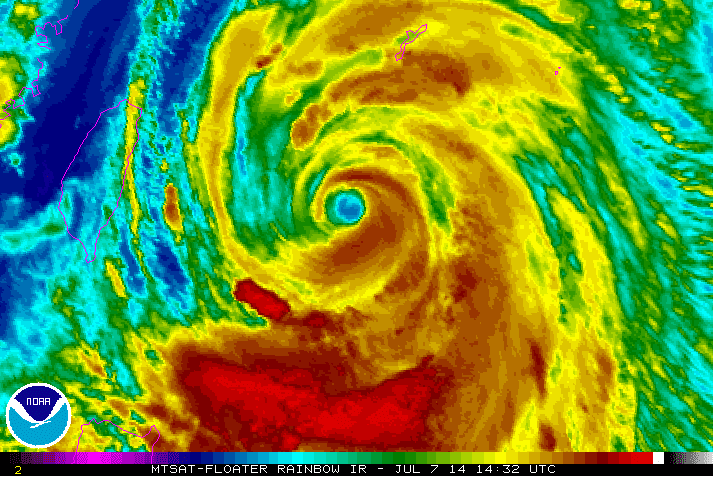Formed September 17, 1999 Fatalities 36 total | Dissipated September 30, 1999 Highest wind speed 259 km/h | |
 | ||
Highest winds 10-minute sustained: 165 km/h (105 mph)1-minute sustained: 260 km/h (160 mph) Lowest pressure 930 hPa (mbar); 27.46 inHg Damage $155 million (1999 USD) Date 17 September 1999 – 30 September 1999 Similar Typhoon Yancy, Typhoon Songda, Typhoon Mireille, Typhoon Flo, Typhoon Dan | ||
Satellite imagery of typhoon bart 1999
Super Typhoon Bart, known in the Philippines as Typhoon Oniang, was a powerful and destructive typhoon that occurred during the 1999 Pacific typhoon season. It was the only super typhoon of that year. The natural phenomenon reached "super typhoon" status on September 22, when it grew to comprise winds containing a force of 260 kilometres per hour (160 mph).
Contents

Super Typhoon Bart claimed at least two lives on the island of Okinawa and brought over 710 millimetres (28 in) of rain to the island. Kadena Air Base was badly damaged by the typhoon, with over $5 million of damage sustained by the base. Heavy flooding and landslides led to a death toll of 30 and over 1,000 injuries in Japan. Over 800,000 homes lost power, whilst 80 000 were damaged in the aftermath of the storm. The worst damage occurred in Kumamoto Prefecture on the island of Kyūshū, where 16 people died and over 45,000 homes were damaged.

Meteorological history
Tropical Depression 24-W developed midday on September 17, to the east of Taiwan. JTWC and JMA both initiated tropical depression warnings on the developing low. The depression initially remained quasi-stationary in weak steering currents while located about 400 mi (640 km) east-northeast of northern Luzon. The development of this system was hindered somewhat due to northwest wind shear. This kept the center exposed from the deep convection. Around 1200 UTC on September 18, there were signs that the shear was beginning to lessen a bit, and by 1800 UTC, a tropical upper tropospheric trough (TUTT) was far enough west to lead to more favorable conditions for strengthening and JTWC upgraded the depression to Tropical Storm Bart early the next day.
A Tropical Rainfall Measurement Mission (TRMM) pass indicated deep convection extending northwest through southwest around the vortex with two developing low-level cloud bands to the north. Bart intensified further as it turned to the northeast under the influence of upper-level winds. By the morning hours of September 20, Bart had developed better defined banding features and a well-defined eye, the cyclone reached typhoon status. Due to the weakening of a subtropical ridge to the north, the typhoon's motion nearly stalled. Passing 75 kilometres (47 mi) southwest of Okinawa, Bart became an intense typhoon on September 21.
Typhoon Bart reached its peak on September 22 with 260 km/h (160 mph) winds when it passed 75 km (47 mi) to the west of the island, becoming the only Super Typhoon during 1999. Bart began to weaken slowly as it continued north towards Kyūshū, Japan, which it struck on September 23 with 185 kilometres (115 mi) winds. After crossing Kyūshū and westernmost Honshū the storm accelerated to the northeast in the Sea of Japan, becoming an extratropical cyclone shortly before it reached northern Hokkaidō.
As Typhoon Bart formed in the Philippine Atmospheric, Geophysical and Astronomical Services Administration (PAGASA)'s area of responsibility, it was named "Oniang" by PAGASA before it moved to the north.
Impact
In Japan, Bart claimed at least two lives on Okinawa and brought over 710 mm (28 inches) of rain to the island. Kadena Air Base was badly damaged by the typhoon, with over $5 million of damage done to the base. Heavy flooding and landslides led to total of a 30 deaths and over 1,000 injuries in Japan. Over 800,000 homes lost power and 80,000 were damaged in the aftermath of the storm. The worst damage was in Kumamoto Prefecture on Kyūshū, where 16 people died and over 45,000 homes were damaged.
Bart affected the whole of Japan, with some minor damages occurring in Hokkaidō shortly after the storm became extratropical. A large crane in Hiroshima collapsed killing 3 and injuring 4 people in the Mitsubishi plant, and the Itsukushima Shrine was also damaged.
A total of 36 people lost their lives and another 1,077 sustained injury. Damage from the storm amounted to ¥16.31 billion (US$155 million); insurance payouts reached ¥31.47 billion (US$299 million).
